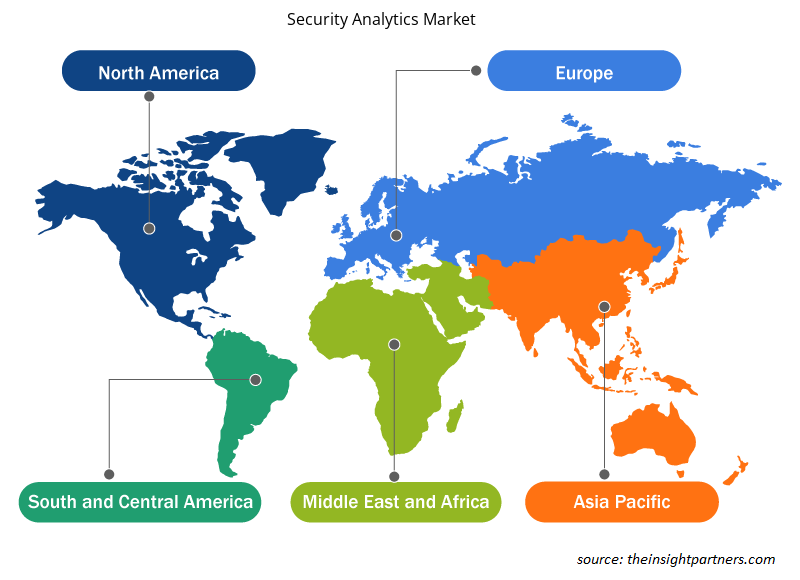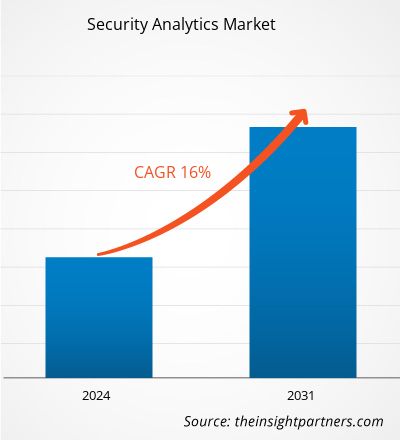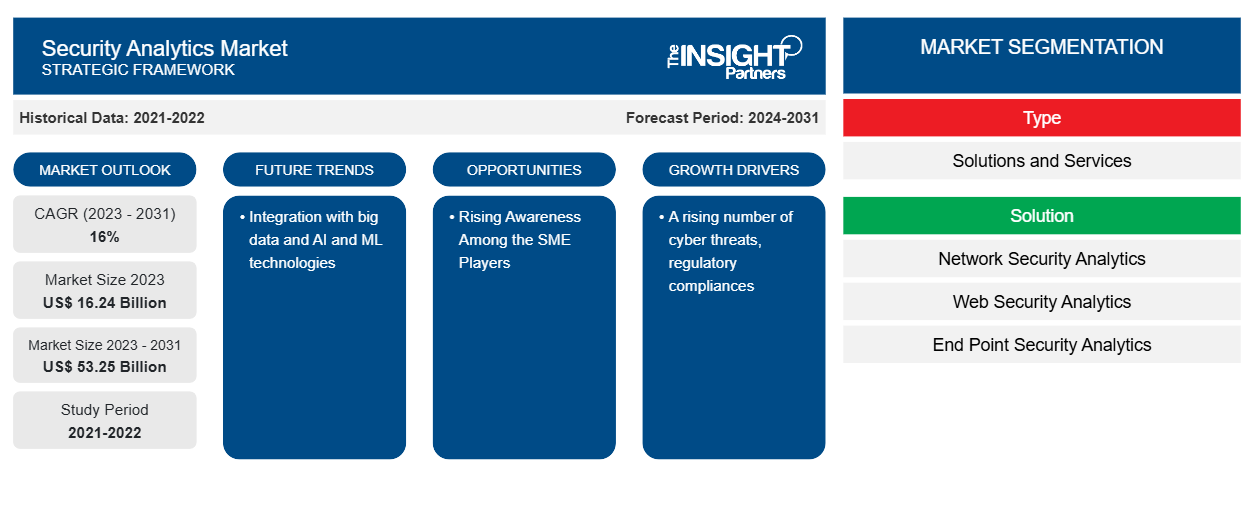Si prevede che il mercato dell'analisi della sicurezza raggiungerà i 53,25 miliardi di dollari entro il 2031, rispetto ai 16,24 miliardi di dollari del 2023.Si prevede che il mercato registrerà un CAGR del 16,0% nel periodo 2023-2031. L'integrazione con i big data e le tecnologie AI e ML rimarrà probabilmente una tendenza chiave nel mercato.
Analisi di mercato dell'analisi della sicurezza
L'analisi della sicurezza sta diventando sempre più importante per mantenere la sicurezza aziendale, poiché le reti continuano a cambiare e le minacce alla sicurezza diventano più sofisticate. L'analisi della sicurezza aiuta i team IT e di sicurezza a identificare in modo proattivo (e reattivo) le minacce prima che causino perdite di dati o altre conseguenze negative, unendo software, algoritmi e procedure analitiche.
Panoramica del mercato dell'analisi della sicurezza
Machine learning, analisi comportamentale e personalizzazione sono le principali forze alla base del progresso nella tecnologia di analisi della sicurezza odierna. Invece di richiedere agli utenti di utilizzare data lake proprietari, diversi pacchetti SIEM ora consentono alle aziende di utilizzare quelli attuali. Inoltre, diverse soluzioni hanno reso pubblici i loro modelli di machine learning, arricchimento e analisi in modo che i clienti possano comprenderli meglio e adattarli secondo necessità. Per affrontare il rilevamento e la risposta alle minacce in modo più automatizzato e ricco di telemetria, il settore sta iniziando a integrare SIEM, User Entity Behavioral Analytics (UEBA), Security Orchestration, Automation and Response (SOAR) ed Extended Detection and Response (XDR). L'analisi della sicurezza è progredita rapidamente negli ultimi anni.
Personalizza questo report in base alle tue esigenze
Riceverai la personalizzazione gratuita di qualsiasi report, comprese parti di questo report, o analisi a livello nazionale, pacchetto dati Excel, oltre a usufruire di grandi offerte e sconti per start-up e università
-
Scopri le principali tendenze di mercato in questo rapporto.Questo campione GRATUITO includerà analisi di dati che spaziano dalle tendenze di mercato alle stime e alle previsioni.
Driver e opportunità del mercato dell'analisi della sicurezza
Crescenti minacce informatiche favoriscono il mercato
Grazie alla sua capacità di sfruttare tecnologie all'avanguardia per rilevare possibili minacce, rivelare vulnerabilità nascoste e fornire alle organizzazioni informazioni che consentono loro di rafforzare le proprie difese e mitigare proattivamente i rischi, l'analisi della sicurezza è diventata uno strumento indispensabile nella lotta continua contro i criminali informatici. Secondo un rapporto del 2024 di Check Point Software Technologies Ltd., nel 2023 si è registrato un aumento costante delle minacce informatiche. Ogni settimana si sono verificati in media 1158 attacchi informatici contro le aziende in tutto il mondo. Ciò indica una tendenza costante e preoccupante nel panorama delle minacce digitali, con gli attacchi informatici in aumento dell'1% rispetto al 2022 e mantenendo la notevole crescita degli anni precedenti. Ciò sta guidando il mercato dell'analisi della sicurezza.cybercriminals. According to a 2024 report by Check Point Software Technologies Ltd., there has been a steady increase in cyber threats in 2023. Every week, there were an average of 1158 cyberattacks against businesses worldwide. This indicates a consistent and concerning trend in the digital threat landscape, with
Crescente consapevolezza tra gli attori delle PMISME Players
Un sondaggio della CyberPeace Foundation afferma che il 43% di tutti gli attacchi informatici ha come obiettivo startup e piccole aziende. Inoltre, circa il 46% delle PMI non ha conoscenze sulla gestione del rischio nel regno digitale. Le minacce informatiche sono una minaccia reale e i loro metodi operativi stanno diventando più sofisticati. Mentre la maggior parte delle grandi organizzazioni consolidate ha le misure di sicurezza adeguate per difendersi da pericoli come malware e violazioni dei dati, le piccole aziende sono più vulnerabili ai rischi per la sicurezza informatica a causa delle loro risorse limitate. Pertanto, ciò apre opportunità per l'adozione di strumenti di analisi della sicurezza tra le PMI.CyberPeace Foundation survey states that 43% of all cyberattacks target startups and small companies. Also, roughly 46% of SMEs lacked knowledge of Cyber threats are a real threat, and their methods of operation are getting more sophisticated. While the majority of large, well-established organizations have the proper security measures in place to fend off dangers like malware and data breaches, small businesses are more vulnerable to cybersecurity risks because of their constrained resources. Thus, this opens up opportunities for the adoption of security analytics tools among the SMEs.
Analisi della segmentazione del rapporto di mercato dell'analisi della sicurezza
I segmenti chiave che hanno contribuito alla derivazione dell'analisi di mercato dell'analisi della sicurezza sono tipologia, soluzione, distribuzione e settore verticale.
- In base al tipo, il mercato Security Analytics è suddiviso in soluzioni e servizi. Il segmento delle soluzioni ha detenuto la quota maggiore nel 2023.
- In base alla soluzione, il mercato è suddiviso in analisi della sicurezza di rete, analisi della sicurezza web, analisi della sicurezza degli endpoint e altri.
- In base all'implementazione, il mercato si divide in on-premise, cloud e ibrido.
- In base al settore verticale, il mercato è suddiviso in BFSI, telecomunicazioni e IT, governo e difesa, beni di consumo e vendita al dettaglio e altri.
Analisi della quota di mercato dell'analisi della sicurezza per area geografica
L'ambito geografico del rapporto di mercato sull'analisi della sicurezza è suddiviso principalmente in cinque regioni: Nord America, Asia Pacifico, Europa, Medio Oriente e Africa, Sud e Centro America.
Il Nord America detiene una quota significativa del mercato dell'analisi della sicurezza nel 2023. Il Nord America è una delle regioni più colpite al mondo dagli attacchi informatici. Ciò è dovuto alla presenza di spicco di settori finanziari, infrastrutture essenziali e opportunità condivise, come partnership pubblico-private, che contribuiscono tutte a un ecosistema informatico più solido. I governi regionali si concentrano sul miglioramento della legislazione e delle politiche per combattere i rischi informatici nei loro paesi. Ciò sta guidando la domanda per il mercato dell'analisi della sicurezza nella regione.
Approfondimenti regionali sul mercato dell'analisi della sicurezza
Le tendenze regionali e i fattori che influenzano il Security Analytics Market durante il periodo di previsione sono stati ampiamente spiegati dagli analisti di Insight Partners. Questa sezione discute anche i segmenti e la geografia del Security Analytics Market in Nord America, Europa, Asia Pacifico, Medio Oriente e Africa e Sud e Centro America.

- Ottieni i dati specifici regionali per il mercato dell'analisi della sicurezza
Ambito del rapporto di mercato sull'analisi della sicurezza
| Attributo del report | Dettagli |
|---|---|
| Dimensioni del mercato nel 2023 | 16,24 miliardi di dollari USA |
| Dimensioni del mercato entro il 2031 | 53,25 miliardi di dollari USA |
| CAGR globale (2023-2031) | 16% |
| Dati storici | 2021-2022 |
| Periodo di previsione | 2024-2031 |
| Segmenti coperti |
Per tipo
|
| Regioni e Paesi coperti |
America del Nord
|
| Leader di mercato e profili aziendali chiave |
|
Densità degli attori del mercato dell'analisi della sicurezza: comprendere il suo impatto sulle dinamiche aziendali
Il mercato Security Analytics Market sta crescendo rapidamente, spinto dalla crescente domanda degli utenti finali dovuta a fattori quali l'evoluzione delle preferenze dei consumatori, i progressi tecnologici e una maggiore consapevolezza dei vantaggi del prodotto. Con l'aumento della domanda, le aziende stanno ampliando le loro offerte, innovando per soddisfare le esigenze dei consumatori e capitalizzando sulle tendenze emergenti, il che alimenta ulteriormente la crescita del mercato.
La densità degli operatori di mercato si riferisce alla distribuzione di aziende o società che operano in un particolare mercato o settore. Indica quanti concorrenti (operatori di mercato) sono presenti in un dato spazio di mercato in relazione alle sue dimensioni o al valore di mercato totale.
Le principali aziende che operano nel mercato dell'analisi della sicurezza sono:
- Società IBM
- Sviluppo aziendale Hewlett Packard (HPE)
- Cisco Systems, Inc.
- Società per azioni Broadcom, Inc.
- Società
- Azienda
Disclaimer : le aziende elencate sopra non sono classificate secondo un ordine particolare.

- Ottieni una panoramica dei principali attori del mercato dell'analisi della sicurezza
Notizie di mercato e sviluppi recenti dell'analisi di sicurezza
Il mercato Security Analytics viene valutato raccogliendo dati qualitativi e quantitativi dopo la ricerca primaria e secondaria, che include importanti pubblicazioni aziendali, dati associativi e database. Di seguito sono elencati alcuni degli sviluppi nel mercato Security Analytics:
- IBM (NYSE: IBM) ha annunciato oggi un'importante evoluzione del suo prodotto di punta IBM QRadar SIEM: riprogettato su una nuova architettura cloud-native, creata appositamente per scalabilità, velocità e flessibilità del cloud ibrido. IBM ha inoltre svelato i piani per fornire funzionalità di intelligenza artificiale generativa all'interno del suo portafoglio di rilevamento e risposta alle minacce, sfruttando Watsonx, la piattaforma di dati e intelligenza artificiale pronta per l'azienda. (Fonte: IBM, comunicato stampa, novembre 2023)
- Symantec, una divisione di Broadcom Inc. (NASDAQ: AVGO), collabora con Google Cloud per integrare l'intelligenza artificiale generativa (gen AI) nella piattaforma Symantec Security in un'implementazione graduale che offrirà ai clienti un vantaggio tecnico significativo per rilevare, comprendere e porre rimedio a sofisticati attacchi informatici. (Fonte: Broadcom Inc., comunicato stampa, settembre 2023)
Copertura e risultati del rapporto di mercato sull'analisi della sicurezza
Il rapporto "Dimensioni e previsioni del mercato dell'analisi della sicurezza (2021-2031)" fornisce un'analisi dettagliata del mercato che copre le seguenti aree:
- Dimensioni e previsioni del mercato dell'analisi della sicurezza a livello globale, regionale e nazionale per tutti i segmenti di mercato chiave coperti dall'ambito
- Tendenze del mercato dell'analisi della sicurezza, nonché dinamiche di mercato quali driver, limitazioni e opportunità chiave
- Analisi dettagliata delle cinque forze PEST/Porter e SWOT
- Analisi di mercato dell'analisi della sicurezza che copre le principali tendenze del mercato, il quadro globale e regionale, i principali attori, le normative e i recenti sviluppi del mercato
- Analisi del panorama industriale e della concorrenza che copre la concentrazione del mercato, l'analisi della mappa di calore, i principali attori e gli sviluppi recenti per il mercato dell'analisi della sicurezza
- Profili aziendali dettagliati
- Analisi storica (2 anni), anno base, previsione (7 anni) con CAGR
- Analisi PEST e SWOT
- Valore/volume delle dimensioni del mercato - Globale, Regionale, Nazionale
- Industria e panorama competitivo
- Set di dati Excel
Report recenti
Rapporti correlati
Testimonianze
Motivo dell'acquisto
- Processo decisionale informato
- Comprensione delle dinamiche di mercato
- Analisi competitiva
- Analisi dei clienti
- Previsioni di mercato
- Mitigazione del rischio
- Pianificazione strategica
- Giustificazione degli investimenti
- Identificazione dei mercati emergenti
- Miglioramento delle strategie di marketing
- Aumento dell'efficienza operativa
- Allineamento alle tendenze normative























 Ottieni un campione gratuito per - Mercato dell'analisi della sicurezza
Ottieni un campione gratuito per - Mercato dell'analisi della sicurezza